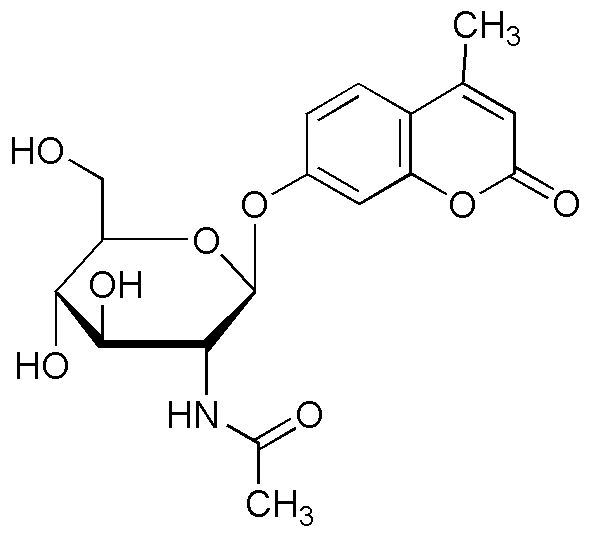4-Methylumbelliferyl-N-acetyl-b-D-glucosaminide is widely utilized in research focused on:
- Enzyme Activity Assays: This compound serves as a substrate for various glycosidases, allowing researchers to measure enzyme activity in biological samples, which is crucial for understanding metabolic pathways.
- Cell Biology Studies: It is used in cell culture experiments to investigate the uptake and metabolism of glycosaminoglycans, providing insights into cellular functions and interactions.
- Diagnostic Applications: The compound can be employed in diagnostic tests for certain diseases, helping in the detection of enzyme deficiencies or abnormalities in glycosylation processes.
- Drug Development: In pharmaceutical research, it aids in screening potential drug candidates that target glycosylation-related pathways, which is vital for developing new therapies.
- Biotechnology: It is utilized in the production of recombinant proteins, enhancing the efficiency of glycosylation processes in biomanufacturing, thus improving product yield and quality.
Informations générales
Propriétés
Sécurité et réglementation
Applications
4-Methylumbelliferyl-N-acetyl-b-D-glucosaminide is widely utilized in research focused on:
- Enzyme Activity Assays: This compound serves as a substrate for various glycosidases, allowing researchers to measure enzyme activity in biological samples, which is crucial for understanding metabolic pathways.
- Cell Biology Studies: It is used in cell culture experiments to investigate the uptake and metabolism of glycosaminoglycans, providing insights into cellular functions and interactions.
- Diagnostic Applications: The compound can be employed in diagnostic tests for certain diseases, helping in the detection of enzyme deficiencies or abnormalities in glycosylation processes.
- Drug Development: In pharmaceutical research, it aids in screening potential drug candidates that target glycosylation-related pathways, which is vital for developing new therapies.
- Biotechnology: It is utilized in the production of recombinant proteins, enhancing the efficiency of glycosylation processes in biomanufacturing, thus improving product yield and quality.
Documents
Fiches de données de sécurité (FDS)
La FDS fournit des informations de sécurité complètes sur la manipulation, le stockage et l’élimination du produit.
Spécifications du produit (PS)
Le PS fournit une description complète des propriétés du produit, notamment sa composition chimique, son état physique, sa pureté et les exigences de stockage. Il détaille également les plages de qualité acceptables et les applications prévues du produit.
Certificats d'analyse (COA)
Recherchez des certificats d'analyse (COA) en saisissant le numéro de lot du produit. Les numéros de lot et de lot se trouvent sur l'étiquette d'un produit, après les mots « Lot » ou « Lot de fabrication ».
Numéro de catalogue
Numéro de lot/série
Certificats d'origine (COO)
Ce certificat d'exploitation confirme le pays dans lequel le produit a été fabriqué, et détaille également les matériaux et composants utilisés et s'il est issu de sources naturelles, synthétiques ou autres sources spécifiques. Ce certificat peut être requis pour les douanes, le commerce et la conformité réglementaire.
Numéro de catalogue
Numéro de lot/série
Fiches de données de sécurité (FDS)
La FDS fournit des informations de sécurité complètes sur la manipulation, le stockage et l’élimination du produit.
DownloadSpécifications du produit (PS)
Le PS fournit une description complète des propriétés du produit, notamment sa composition chimique, son état physique, sa pureté et les exigences de stockage. Il détaille également les plages de qualité acceptables et les applications prévues du produit.
DownloadCertificats d'analyse (COA)
Recherchez des certificats d'analyse (COA) en saisissant le numéro de lot du produit. Les numéros de lot et de lot se trouvent sur l'étiquette d'un produit, après les mots « Lot » ou « Lot de fabrication ».
Numéro de catalogue
Numéro de lot/série
Certificats d'origine (COO)
Ce certificat d'exploitation confirme le pays dans lequel le produit a été fabriqué, et détaille également les matériaux et composants utilisés et s'il est issu de sources naturelles, synthétiques ou autres sources spécifiques. Ce certificat peut être requis pour les douanes, le commerce et la conformité réglementaire.


